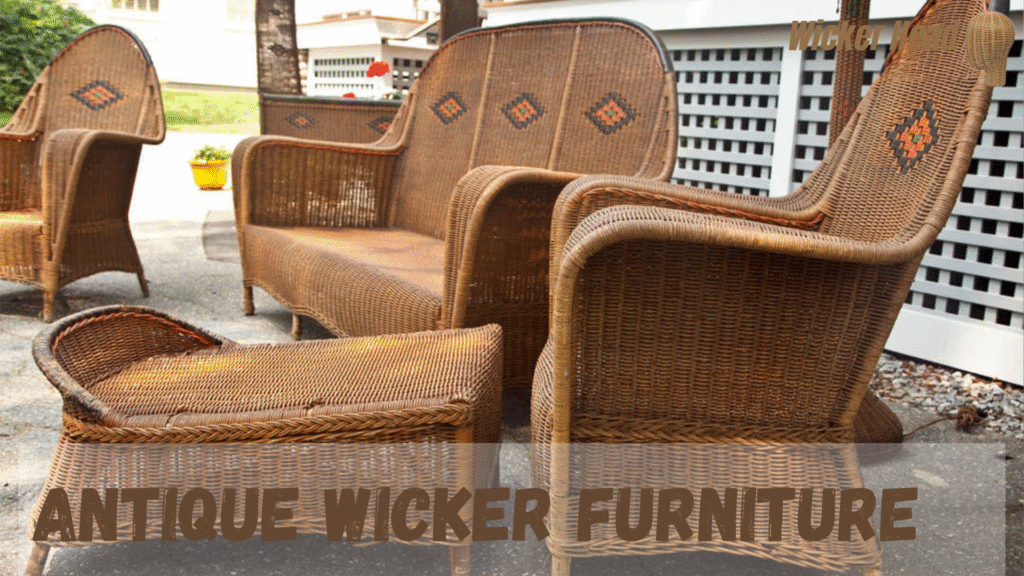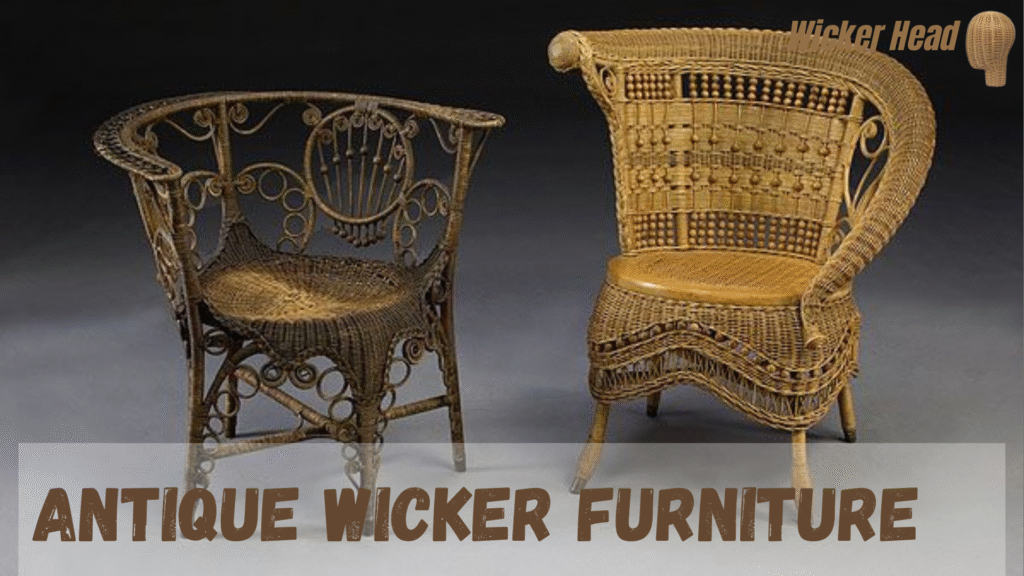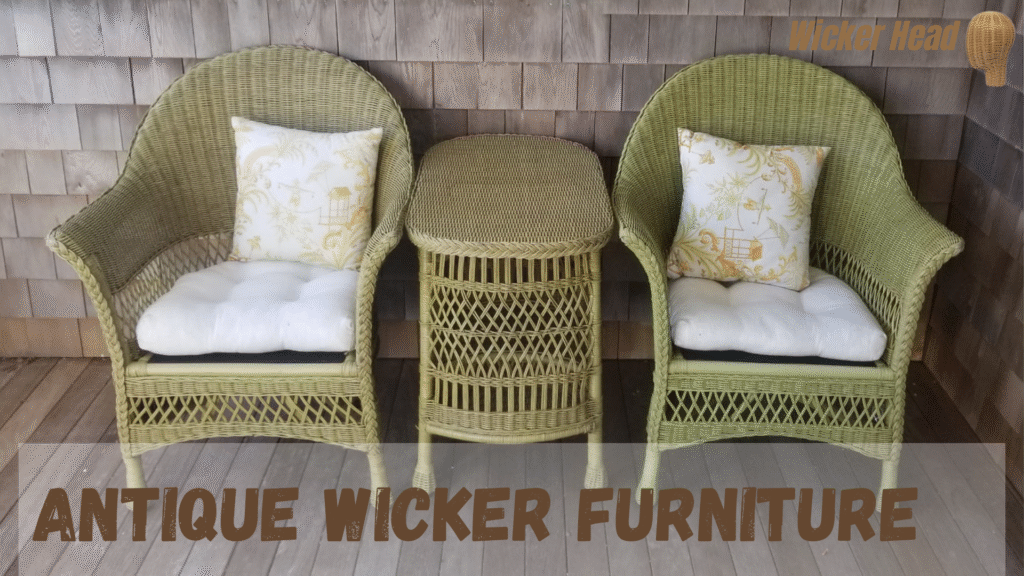Wicker furniture has long been admired for its light, natural beauty and durability. But antique wicker furniture takes that charm to another level. With its detailed craftsmanship, history, and timeless look, antique wicker pieces can turn any room into a stylish, cozy space filled with character.
Whether you’re furnishing a vintage-style bedroom or just want to add a statement piece to your living room, antique wicker furniture offers a blend of artistry and function that modern designs often lack.
What Makes Wicker Furniture “Antique”?
Not all old wicker is considered antique. There’s a difference between vintage and true antique furniture, especially in the world of wicker. Here’s what to look for.
Age Matters
To be considered antique, a piece usually needs to be at least 100 years old. However, some high-quality wicker from the early 20th century is also highly collectible and often labeled as “vintage.”
Handcrafted Details
Antique wicker was often made by hand. You’ll notice intricate weaves, unique patterns, and design elements that are hard to find in mass-produced furniture today.
Natural Materials
Most antique wicker was made using natural materials like rattan, reed, bamboo, or willow. These materials were woven onto sturdy wooden frames, giving each piece strength and beauty.
Maker’s Mark or Label
Some old wicker pieces include a label or stamp from their maker—like Heywood-Wakefield, a famous American wicker manufacturer. These add to the piece’s authenticity and value.
Popular Types of Antique Wicker Furniture
Antique wicker isn’t limited to one type of piece. From cozy chairs to elegant dressers, the options are wide and wonderfully unique.
Wicker Rocking Chairs
These pieces are often found on porches but were also popular in nurseries and bedrooms. Their soothing motion and woven comfort make them a favorite.
Victorian Wicker Chairs
With high backs, detailed curves, and lace-like patterns, Victorian-era wicker chairs are true statement pieces. They’re often painted white or cream.
Wicker Baskets and Trunks
Not just decorative, antique wicker baskets were used for storage, travel, and even laundry. Their large size and sturdy construction make them useful and collectible today.
Wicker Sofas and Settees
These longer seating pieces were used in sunrooms and parlors. They often come with intricate arms and legs that showcase the craft of early wicker weaving.
For a closer look at styles and details, check out WickerHead, where vintage inspiration meets modern guidance.
Table of Contents
Why People Love Antique Wicker Furniture
There’s something magical about furniture that tells a story. Antique wicker isn’t just old—it’s timeless, stylish, and deeply personal.
Tells a Story
Every antique piece has a history. Whether passed down through generations or discovered at a market, each scratch and curve holds a memory.
Built to Last
Despite being over a century old, well-kept antique wicker can still be sturdy and functional. It was made to last, not for quick sales.
One-of-a-Kind Beauty
Unlike modern furniture, antique wicker pieces are rarely identical. Hand-weaving and natural materials mean every piece is slightly different.
Adds Charm to Any Space
Whether your home is rustic, boho, or traditional, antique wicker furniture fits right in. Its warmth and texture elevate any room.

How to Style Antique Wicker in Modern Homes
You don’t need a house full of vintage furniture to enjoy antique wicker. A single piece can add charm, contrast, and personality to modern spaces.
Mix with Modern Pieces
Place an antique wicker chair next to a sleek metal lamp or modern coffee table. The contrast highlights the charm of both styles.
Use in Unexpected Places
Try placing an antique wicker trunk at the foot of your bed or use a vintage basket as a plant holder in the living room.
Keep the Palette Simple
Neutral tones help antique wicker stand out. Use soft whites, creams, and pastels to enhance its detail and craftsmanship.
Balance with Soft Textures
Pair antique wicker with cushions, throws, or linen curtains to create a cozy, inviting look that’s never outdated.
Caring for Antique Wicker Furniture
Old wicker needs care to stay beautiful. With gentle maintenance, you can preserve your furniture’s charm for years to come.
Dust Weekly
Use a soft brush or vacuum with a brush attachment to remove dust from the weave. Dust can settle deep in the cracks if left too long.
Clean Gently
Avoid soaking wicker. Use a damp cloth with mild soap to spot clean. Wipe dry immediately to prevent moisture damage.
Protect from Moisture
Keep antique wicker away from humid areas or direct water. Moisture can cause swelling, mold, or warping of the fibers.
Avoid Direct Sunlight
Too much sun can cause wicker to dry out and fade. Place antique furniture in shaded spots or use curtains to filter light.
Where to Find Antique Wicker Furniture
Authentic antique wicker furniture can be found in a few special places if you know where to look.
Estate Sales and Auctions
These often offer high-quality, well-preserved pieces. You may find sets or rare designs not available elsewhere.
Antique Shops
Many antique stores carry curated collections of wicker furniture, and staff can often give you details about each piece’s history.
Online Marketplaces
Websites like eBay, Etsy, or local listings can be goldmines for antique wicker. Always ask for clear photos and close-ups.
Specialty Stores
Retailers like WickerHead may guide you to both antique and antique-style wicker pieces, helping you mix old and new.
How to Identify Real Antique Wicker
Not all wicker labeled “antique” is the real deal. Spotting true antiques takes a bit of observation and care.
Look for Wear and Patina
Antique wicker will show signs of use—worn corners, aged patina, or slight color fading. These imperfections add authenticity.
Check Materials
Older wicker tends to use natural materials like rattan or reed. If it looks like plastic or resin, it’s probably a reproduction.
Examine Weaving Style
Hand-woven pieces have slight variations and irregularities. Machine-made wicker often looks too perfect or uniform.
Look for Brand Stamps
Some older wicker furniture includes a mark or stamp, especially from companies like Heywood-Wakefield or Lloyd Loom.

Restoring and Repairing Antique Wicker
Sometimes antique pieces need a little love. Light repairs or restoration can bring them back to life while keeping their history intact.
Tighten Loose Weaves
If small areas of the weave have come loose, you can often re-thread them gently using tweezers or a weaving tool.
Repaint Carefully
If you want to refresh the color, use a soft-bristle brush and matte paint. Avoid heavy spray painting which can clog the weave.
Replace Missing Parts
Some skilled craftsmen specialize in wicker repair. They can rebuild arms, legs, or sections using matching materials.
Clean Before Restoring
Before any repair, give your furniture a gentle clean to avoid sealing in dirt or moisture with paint or glue.
Decorating with Antique Wicker on a Budget
You don’t have to spend a fortune to enjoy the charm of antique wicker. With the right approach, you can find and style beautiful pieces affordably.
Start Small
Begin with a single piece like a side table, chair, or mirror frame. Small items are usually more affordable and easier to style.
Repurpose Old Pieces
An old wicker basket can become wall décor. A broken wicker chair can be turned into a plant stand or shelf.
Mix with Thrifted Finds
Combine antique wicker with other secondhand items like vintage lamps or rugs for a cohesive, budget-friendly setup.
Shop Out of Season
Antique stores often offer discounts during the off-season. Summer and fall tend to have higher prices due to demand.
Conclusion: Bring Timeless Charm Into Your Home
Antique wicker furniture is more than just old—it’s elegant, artistic, and full of character. From hand-woven chairs to storage trunks, these pieces carry history, craftsmanship, and a sense of warmth that new furniture often can’t replicate.
Whether you’re collecting, decorating, or restoring, antique wicker has a place in every style of home. It blends effortlessly with modern designs, creates conversation, and adds a sense of soul to any room.
To explore timeless wicker styles—new and old—visit WickerHead and find the perfect addition for your home today.

Frequently Asked Questions (FAQs)
1. How old does wicker furniture have to be to be considered antique?
Generally, a piece is considered antique if it’s over 100 years old. However, some vintage pieces from the early 1900s are also highly collectible.
2. Is antique wicker furniture still strong enough to use?
Yes, if well-maintained, antique wicker can still be strong and functional. Look for pieces with sturdy frames and tight weaving.
3. Can antique wicker furniture be painted?
Yes, but it should be done gently. Use a soft brush and breathable paint. Avoid clogging the weave with heavy coats.
4. What’s the best way to clean antique wicker?
Use a dry brush or vacuum with a soft attachment. For stains, a damp cloth with mild soap works well. Avoid soaking it.
5. Where can I find real antique wicker furniture?
Estate sales, antique shops, auctions, and specialized online stores like WickerHead are great places to start.
6. How do I know if my wicker is hand-woven?
Look for slight irregularities and uneven strands. Hand-woven wicker is never 100% uniform, unlike machine-made pieces.
7. Can antique wicker furniture be repaired?
Yes, loose or damaged sections can often be fixed by a professional or through DIY if the damage is small.
8. Is antique wicker safe to use for outdoor spaces?
Not really. Antique wicker is best kept indoors or in covered areas. Exposure to rain or sun can damage natural fibers.
9. What styles pair well with antique wicker furniture?
Coastal, bohemian, rustic, and even modern styles work well. It adds charm and contrast to nearly any decor.
10. Does antique wicker furniture hold value?
Yes, especially well-preserved or rare pieces from known makers. Condition, craftsmanship, and age all affect its value.

